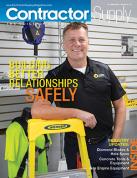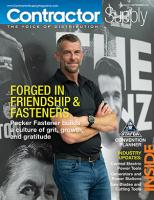Jason Bader: What’s wrong with these kids?
Learning to Manage Your New Warehouse Employees
Man, I feel old when I start referring to the next generation of employees in the distribution world as “kids.” But let’s face facts, it has been over 25 years since I started working in the warehouse of my family distribution business. Things have changed. The way the job is done has changed. Much to the consternation of many warehouse managers, the behavior of the entry level employee has changed.
This past year I have been teaching a warehouse operations course sponsored by the American Supply Association in cities across the United States. Many of the participants manage distribution warehouses or some aspect of the warehouse function.
In the beginning of each course, I invite participants to share their biggest frustrations. The most common response is some variation on the theme of trying to manage this next generation of employee, often followed by, “In my day…”
In most privately held distribution companies, new employees start in the warehouse. Since promotion from within is the most common mode of operation, assimilating these new employees into the company culture falls to the warehouse manager. Have we given them the tools to facilitate this responsibility?
| The most frustrating thing for many older managers is that their newer employees think differently about work than they do. |
The most frustrating thing for many older managers is that their newer employees think differently about work than they do. Leaders often expect new employees to learn the same way that they did, and to share their work ethic. As a result, managers often look at this new generation as lazy or lacking in discipline.
While some of this may be true, one can also make the argument that some of this “laziness” is the manager’s, not the employee’s. Managers are often so focused on the way they were taught that they often fail to take the time to understand the motivations and influences that have shaped this new crop of distribution professionals.
Several years ago, I managed a regional facility in Denver. I oversaw about 20 employees ranging in age from 19 to 56. I found myself constantly frustrated in my efforts to shape this team into a cohesive unit. They just wouldn’t follow procedures. I would fire off e-mails and memos, expecting the pen to be mightier than the sword.
I couldn’t get anything done because people would drop by my office all day to discuss problems we had gone over the week earlier. Couldn’t they just send me an e-mail? Then there would be a record of the question and the subsequent answer. It made a whole lot of sense to me, but for some reason these folks wanted to talk it out.
In one less than stellar managerial moment, I unloaded on my counter manager and bellowed, “Didn’t you get my e-mail?” He replied, “Oh, I only look at e-mail once a week.” After I picked my jaw off the ground, I was struck with a monumental thought — he doesn’t work the same way I do.
After this enlightening encounter, I started to look for ways to understand the people I was supposed to manage. I researched generational motivation and the different generations that make up the workplace. I bought the book, Connecting Generations, by Claire Raines and read it cover-to-cover in a weekend. I still recommend this book. It changed me as a manager, a salesman and as a person.
This book talks about the four generations of employees in our workforce: the Traditionals, the Boomers, Generation X and the Millennials. I was floored when I read the section on Generation X. Raines nailed my personality to a tee. In her book, she explained some of the influential moments that shaped certain behaviors. She had me at, “they usually are unimpressed with authority figures.”
More importantly, this study of generational differences gave me some insight into working with the different people I was charged with managing. No longer did one size fit all. I was able to tailor my approach based on the generational cues of the employee. I believe that a great deal of frustration expressed by our warehouse management could be alleviated by just taking the time to learn about what makes millennial generation employees tick.
In writing this article, I went back to the generationsatwork.com Web site where Claire Raines and her team present articles and information on the subject. In an article titled “Millennials at Work,” Raines and Arleen Arnsparger outline several keys to understanding and working with this generation.
Some of the more interesting parts of the article focused on some of the early influences that shaped behavior. These kids were extremely busy children. They were loaded with extra-curricular activities. They had very tight schedules and parents who managed their time for them. Parents of this generation were often called “helicopter” parents because they would “hover” over their children.
From a managerial perspective, we should recognize that millenials tend to be used to a great deal of structure. They will probably have some challenge around self-directed assignments early on. Since they were used to a very strong parental influence, managers will need to provide constant feedback and direction. They respond well to a strong parent-like mentor in the workplace.
Communication will also be a challenge. The millenial generation grew up communicating through electronic devices. Personal interaction will be difficult at first.
Extended group meetings will be uncomfortable, but there is a silver lining. This generation was heavily influenced by humanitarian efforts, such as Hurricane Katrina, and will thrive when asked to work in a team environment.
This group of new employees is highly ethical. They grew up in a time where corporate greed was coming to a head and the sins of Enron and Worldcom were splashed across the news. They will respond to leaders who have integrity and view business transactions as win-win.
I have just given you a taste of the conclusions that can be drawn from understanding generational differences. I hope you choose to dig deeper. Are these generational characterizations going to be perfect? Of course not, there will always be exceptions to the rule.
When you get into the study of generational influences, look for the similarities to your current employees. Don’t dwell on the differences. Remember, these kids aren’t wrong, they just view the world with a slightly different set of glasses. Good luck. CS
Jason Bader is the managing partner of The Distribution Team, which specializes in helping distributors become more profitable through operating efficiencies. He is regular speaker at industry events and spends much if his time working with individual distributors. He can be reached at (503) 282-2333 or Jason@Distributionteam.com, or visit www.thedistributionteam.com.

















